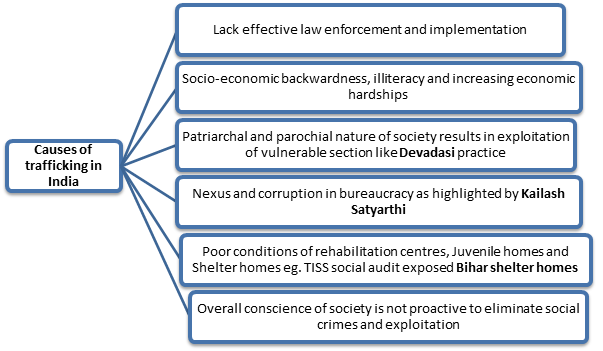-
- It prohibits traffic in human beings, begar (forced labour) and other similar forms of forced labour.
- ‘begar’ means compulsory work without remuneration
- ‘forced labour’ means compelling someone to work against will
- It is available to both citizens and non-citizens.
- It protects individual not only against the State but also against private persons.
- It prohibits traffic in human beings, begar (forced labour) and other similar forms of forced labour.
The expression ‘traffic in human beings’ include:
Ø Selling and buying of men, women and children like goods
Ø Immoral traffic in women and children, including prostitution
Ø Devadasis
Ø Slavery
Facts:
-
- According to NCRB, there are 10,659 cases of human trafficking between 2018 and 2022.
- Trafficking is considered as third largest source of profit for organized crime.
- According to legal services in India, 4 girls enter into prostitution in India every hour, of which 3 against their wish.
Article 23(2) provides for an exception by permitting the State to impose compulsory service without pay for public purposes, like military service, social service etc. However, during this, the State cannot discriminate on grounds only of religion, race, caste or class.
Policy and legal interventions
-
- Immoral Traffic (Prevention) Act of 1956
- Bonded Labour System (Abolition) Act, 1976
- Contract Labour Act, 1970,
- Equal Remuneration Act, 1976
Judicial orders:
-
- People’s Union for Democratic Rights (PUDR) v. Union of India, 1983: upheld the right to a minimum wage and equal pay for equal work
- Sanjit Roy vs State of Rajasthan, 1983: economic coercion is a form of forced labor
- Ram Lakhan v State, 2006: dealt with anti-begging laws

Way forward:
-
- Reforming police and criminal justice system for improving law enforcement.
- Active role of institutions like National Human Rights Commission, SC & ST Commission.
- S. Verma Committee: No need for a new law rather better enforcement of the existing one.
- Enhance judicial efficiency and ADR (Alternative Dispute Resolution) system for effective grievance redressal.
- Encourage active role of CSOs.

